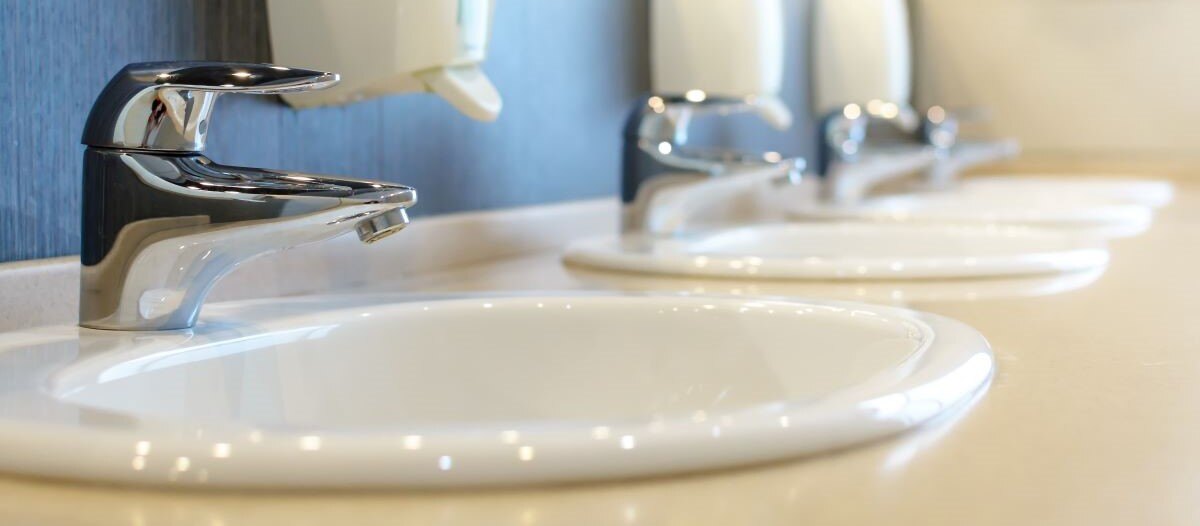A Better Way to Go
Getting smart about smart restroom technology

Thanks to the 1980s, there are countless pop culture trends and iconic historical moments, like neon colors, crimped hair, the mixtape, and Rubik’s Cube, the first MTV Music Awards, Prince Charles’ wedding to Lady Diana Spencer and the recording of “We Are the World.” The 1980s was also memorable for defining technology milestones, including the introduction of the personal computer, the launch of handheld gaming and opening of City Place Building in Hartford, Connecticut USA, the first intelligent building in the world.
In 1984, two years after City Place opened, the New York Times wrote about “a new generation of buildings” touting smart buildings’ ability “almost to think for themselves.” After 40 years of explosive technology growth, that description seems truer than ever with solutions available to make virtually every building system and tenant touchpoint smart.
Smart solutions for HVAC, security, lighting and inventory control have been in use in commercial facilities for decades. As they have proven successful, smart solutions for indoor air quality, building occupancy, disaster management and even restroom maintenance have come to market and are quickly gaining momentum. Facility managers, it seems, recognize the value of these solutions in terms of productivity, sustainability, safety, tenant satisfaction, and return-on-investment. According to Fortune Business Insights, in 2021, the global smart building market was valued at US$67.60 billion, but by 2029, the market is projected to hit USD 328.62.
Honing in on smart restroom solutions, which are unique in that they cover a finite number of spaces found throughout a facility rather than a facility at large, it is important that those considering adopting such technology have an awareness of how it works; the intricacies of how it is designed, installed and deployed; and the steps they can take to help make the implementation process as successful as possible.
What makes a smart restroom smart?
 The heart of a smart restroom is the Internet of Things (IoT) and an array of connected devices like sensors, gateways and automation tools. In this analogy, then, what keeps this heart pumping is a networking infrastructure. That infrastructure is what enables those IoT devices – those smart devices – to work together to gather, analyze and communicate data in real time.
The heart of a smart restroom is the Internet of Things (IoT) and an array of connected devices like sensors, gateways and automation tools. In this analogy, then, what keeps this heart pumping is a networking infrastructure. That infrastructure is what enables those IoT devices – those smart devices – to work together to gather, analyze and communicate data in real time.
Getting more specific, sensors embedded into restroom dispensers and fixtures monitor and collect data relevant to usage such as how many times a paper towel, toilet tissue or soap dispenser has been used; how much product remains in a dispenser; how much water is flowing through a faucet or flush valve. They also gather data on potential issues like if a battery is low; if there is a paper jam or water leak; if there is a product malfunction.
All that data is great, but automation tools are necessary to make it actionable. Software and mobile applications, for example, analyze the data from the sensors and provide meaningful insights. These insights can be used to empower informed decision-making, create improved custodian workflows and help facility managers achieve the promise that smart restrooms offer: improvements in the areas of productivity, sustainability, safety, tenant satisfaction and return-on-investment.
A networking infrastructure enables real time communication between the sensors and the automation tools that are accessible to facility managers and custodians. This ability to receive and review real-time data allows FMs to conduct preventive cleaning and maintenance and use the custodial staff in a purposeful and productive way. This infrastructure includes hardware, such as routers, a wireless local area network (LAN) card or wireless router; and software, including an operating system and network security applications; and network services such as wireless protocols or IP addressing.
The ABCs of becoming smart
As is the case with most any kind of technology, smart solutions are more complex than meets the eye. As such, their design, installation and deployment requires a close working relationship between the solution provider and facility to optimize the benefits of the platform. If an FM is new to smart solutions, it is beneficial to have a basic understanding of how a restroom becomes smart.
The first phase in the journey is to determine the type of network infrastructure the solution will leverage. Different solution providers offer varying connectivity options. All are designed to ensure optimal coverage without burdening existing infrastructure. If a site has an existing FM platform, the dispenser data can be fed directly into the third-party platform, allowing data to be displayed on the existing platform in the manner preferred.
With the network infrastructure determined, the next phase is a site survey that includes discovery and mapping. The solution partner will identify the locations of restrooms and network access points; assess dispenser counts based on restroom size and location; determine additional electrical and cabling needs; and create an initial installation plan. Once that plan is finalized, dispensers, collectors and gateways are ordered.
At this point, the network infrastructure, dispensers, and all elements of the smart restroom solution are installed and commissioned. In simplest terms, commissioning consists of powering on the technology, testing and troubleshooting as needed. Certification of the system is not achieved until testing is problem-free. Once certified, the FM and their custodial team download the system software or mobile application, receive training and begin leveraging their data.
Steps for success
Beyond having a basic understanding of how smart restrooms are designed, installed and deployed, there are additional ways FMs can set themselves and their facility up for success.
First, they should ensure top leadership as well as information technology and human resources teams support this effort. Such support is critical to securing the financial and personnel resources needed throughout the implementation process. Also, FMs should communicate with those who will be interacting with the technology daily. This should be done before installation begins to help plant the seeds for their enthusiastic adoption of the technology.
Second, FMs should be mindful of installation timing. Any smart technology implementation will be disruptive to building occupants, so it is important to time installation and deployment to when it will be as least disruptive as possible. Is there a renovation or remodel taking place that a smart restroom project could be included in? Are most individuals in the office on certain days of the week? Are there fewer people in the facility in the summer or during an off-season?
Third, before engaging with a smart restroom solution partner, FMs should identify the pain points to be solved and the goals to be achieved and know what success will look like. Do tenants frequently complain about the state of the restrooms? Are paper towel dispensers often empty? Are custodians as productive as they could be? Do costs need to be cut and sustainability improved? This information will help inform and guide the design and installation processes.
Finally, while being engaged in the day-to-day smart technology implementation process, facility managers should also maintain a focus on the future. There is no “one size fits all” smart restroom solution because no two facilities are the same. For this reason, it is important to commit necessary time for up-front on-boarding and training and to any follow-up support to allow the platform to be optimally applied. This helps make sure that any historic challenges quickly become a distant memory once a smart restroom technology is in place, helping to, among other things, improve the lives of building occupants, lower a facility’s impact on the environment, and influence cost savings. The future is, indeed, bright.

John Strom is vice president and general manager of Connected Solutions at GP PRO, a division of Georgia-Pacific. Drawing on his expertise in operational, commercial, and business management and leveraging his understanding of market-based principles, Strom is helping high traffic facilities across North America, including MLB and NFL stadiums, airports, universities, performance venues, and Class A office buildings, realize the breadth of benefits of smart restroom technology.
References
IoT for All, What is the Internet of Things, published in October 2022: iotforall.com/what-is-internet-of-things
Read more on Technology , Occupancy & Human Factors and Real Estate
Explore All FMJ Topics









